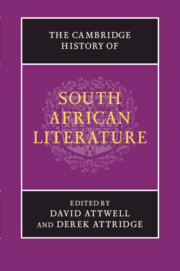Book contents
- Frontmatter
- Introduction
- PART I ORATURES, ORAL HISTORIES, ORIGINS
- PART II EXPLORATION, EARLY MODERNITY AND ENLIGHTENMENT AT THE CAPE, 1488–1820
- PART III EMPIRE, RESISTANCE AND NATIONAL BEGINNINGS, 1820–1910
- 9 Writing settlement and empire: the Cape after 1820
- 10 The mission presses and the rise of black journalism
- 11 The imperial romance
- 12 Perspectives on the South AfricanWar
- 13 The beginnings of Afrikaans literature
- PART IV MODERNISM AND TRANSNATIONAL CULTURE, 1910–1948
- PART V APARTHEID AND ITS AFTERMATH, 1948 TO THE PRESENT
- PART VI SOUTH AFRICAN LITERATURE: CONTINUITIES AND CONTRASTS
- Index
- References
12 - Perspectives on the South AfricanWar
from PART III - EMPIRE, RESISTANCE AND NATIONAL BEGINNINGS, 1820–1910
Published online by Cambridge University Press: 28 January 2012
- Frontmatter
- Introduction
- PART I ORATURES, ORAL HISTORIES, ORIGINS
- PART II EXPLORATION, EARLY MODERNITY AND ENLIGHTENMENT AT THE CAPE, 1488–1820
- PART III EMPIRE, RESISTANCE AND NATIONAL BEGINNINGS, 1820–1910
- 9 Writing settlement and empire: the Cape after 1820
- 10 The mission presses and the rise of black journalism
- 11 The imperial romance
- 12 Perspectives on the South AfricanWar
- 13 The beginnings of Afrikaans literature
- PART IV MODERNISM AND TRANSNATIONAL CULTURE, 1910–1948
- PART V APARTHEID AND ITS AFTERMATH, 1948 TO THE PRESENT
- PART VI SOUTH AFRICAN LITERATURE: CONTINUITIES AND CONTRASTS
- Index
- References
Summary
The twentieth century's first modern war
The Second Anglo-Boer or South African War (1899–1902), commencing in the final months of the nineteenth century and overshadowing the beginning of the war-ridden and genocidal twentieth, represented the first modern war, as is now widely recognised. In terms of its participants, its political and economic impact, and also its literary representation, the war was international in scope in large-scale ways that other late nineteenth-century conflicts like the Crimean and the Spanish-American wars had anticipated but did not match. In technological and military terms, too, the war cast long shadows across twentieth-century world history. In the major formal battles of the war's first pre-guerrilla phase – Elandslaagte, Modder Rivier, Colenso, Magersfontein – modern devices such as the field telephone, hot-air balloon reconnaissance, and the smokeless rifle were used in combination with conventional drillblock advances for the first time. The empire's volunteer army numbered up to a million men, many of them literate and educated, drawn from all corners of the globe – Canada and New Zealand, Ireland and Australia – and the Boers, too, drew on diverse international support, including from France, Russia, the Netherlands, and, again, Ireland. Correspondents hailing from as many countries again reported on activities on both sides. The powerful long-range weaponry, barbed-wire fortified trenches, and, notoriously, concentration camp installations that marked the war, and also the guerrilla tactics the Boers deployed from June 1900, represented critical, even shocking, new departures in the annals of warfare, whose destructive impact, on amass scale, the 1914–18 conflict only magnified.
- Type
- Chapter
- Information
- The Cambridge History of South African Literature , pp. 246 - 261Publisher: Cambridge University PressPrint publication year: 2012
References
- 2
- Cited by

